This page, a working draft of an essay
in galleys, is NOT to be rifled for quotations or attribution. The
essay will appear with IJCS.
If one more person
comes in here
to take a peek, I am going to charge admission.
Pat/Patricia Gaddison
as played by
Robert Reed, née John Robert Reitz[1]
The sacred image, the
liturgical
icon, principally represents Christ. It cannot represent
the
invisible and incomprehensible God, but the incarnation of the Son
of God
has ushered in a new 'economy of images': 'Previously God, who has
neither a
Body nor a face, absolutely could not be represented by an image. But
now that
he has made himself visible in the flesh and has lived with men, I can
make an
image of what I have seen of God . . . and contemplate the glory of the
Lord,
his face unveiled.'
Catechism of the
Catholic
Church[2]
I knew people fooled
around with
each other [in the theater], but I thought it was OK to be by myself.
Paul Reubens[3]

Watching Journalists, Watching Cameras, Watching Sheriffs, Watching Pee-wee Herman Watch
The Extraordinary Case of the Saturday Morning Children's Show Celebrity Who Masturbated <>
William Anthony Nericcio, SDSU
Scene 1 | Scenario For a Scandal/Scandal of a Scenario
You are
alone in a theater
watching a movie, keeping your eyes on the silver screen as photon
facsimiles
of assorted attractive, unclad or scantily clad people touch each
other
with abandon. You note something else as well: appreciable less
time is
being spent on plot development than on sexual intercourse. In the
midst of
this festival of cinematic erotic intrigue, you note that others around
you in
the movie palace--mostly men, mostly men utterly obscured save for an
occasional intrusive flash of light from the screen--have begun to
touch
themselves. Slowly but surely, uncannily but assuredly, you too feel
yourself
similarly moved and you watch amazed as your hand descends
below your
waist, you watch bewildered as you begin to touch yourself. No true
sinning
going on here, one imagines--the species homo sapiens being, after all (and
especially
when it comes to the movies), more lemming-like than it is apt to
admit. The
movie speaks to you and those around you in ways you cannot imagine.
But why be
critical? Why worry about anything at all when such pleasure is right
to hand?
In a peculiar way, you are providing their entertainment. These three, reasonably trained in the arts and sciences of civilian inquisition, are armed and potentially dangerous. Ironically, the three armed men watching you touch yourself as you watch others touch each other, also want to touch you.
And that is not all: they want to bind you, and then, against your will, photograph you, renaming you also with a caption of stark numbers that will proxy for your unseen name.
As this watching, touching conspiracy comes to pass within the dark, sweaty confines of this theater (and not just any theater but one dedicated to a decidedly pornographic dramaturgy), there is, waiting for you in the lobby another unseen witness: a video camera. Albeit inorganic, this sentinel is no less diligent than the undercover officers now surveilling you as you watch and touch and touch and watch. This camera, this electronic eye, also, is waiting to watch you--it will watch you and record what it has seen for others, who will watch you also.
You, too, reading these words--I know you are watching also. But look around you. Who is now watching you?
Scene
2 | An Eye on Sacred Pee-wee at the Video Altar
Was the
preceding scenario a
working gloss for a David Lynch/Atom Egoyan collaborative film? Some
odd
screenplay inspired by the works Gore Vidal, Jeremy Bentham, Michel
Foucault
and Madonna Ciccone? An erotic Hollywood thriller coming soon to a
theater near
you? Not quite.
But there is even more going on as well, however. Returning to the events of that fateful night and to a critical sifting-through of this scandal's coverage, affords us the possibility of profitable intellectual philandering, offering those of us drawn to the allures of cultural study with another opportunity to examine that knotty, always already interesting nexus of gender, sexuality and the "American" body politic. This is made all the more tasty owing to the complex duo of Paul Reubens and his singular alter ego Pee-wee Herman. The alter ego is, of course, the stuff of psychoanalytic/hermeneutic wet-dreams; one does not have to be a student or aficionado of doppelgŠngers to understand that anytime someone presents themselves as someone other than who they might otherwise appear to be, there will be room for a general consideration of Identity and Disguise, existentialism and camouflage--domains with long-standing traditions of discussion in the Humanities, but domains, also, made much more salient, not to mention politically pertinent, by technological advances in video surveillance and image dissemination/dissimulation.[4]
Pee-wee Herman's case is even more intriguing as his particular mode of performance, the particulars by which he becomes his alter ego, brings us to the general terrain of transvestites, persons who dress as exemplars of that which they are not. Pee-wee, in fact, provides us with the opportunity to rethink the semantic/political contours of gender and transvestism. Certainly transvestism introduces here the thematics of costuming and camouflage, but it may also be seen alternatively and simultaneously as a cultural practice that disturbs the visuo/political order of things. Reflecting back on the events surrounding the coverage, that is to say, the creation, of the Pee-wee Herman controversy, we find ourselves rehearsing a scenario wherein the semantic domain of transvestism expands, revealing itself as synonymous with strategic inversion, diastrophism, displacement and ruptureÑin short, transvestism as revolutionary praxis and fun to boot!
The general premise though, and this returns us to the specifics of Paul Reubens's case, is that the transvestite is that threat to the status-quo that the status-quo must regulateÑand not only so that one will not be outdressed. Transvestites must be guarded and policed, surveyed and isolated, if not eradicated entirely--and not just now in the age of high priest prude Attorney General John Ashcroft but in the past as well.
So it
is of no little importance
to the essay twitching here in your hands that we see Paul Reubens
dressing up
as Pee-wee Herman as an act of transvestism--doing so puts us in a
better
position to understand the avalanche of media coverage which attended
to his
arrest and was attendant upon the scandal which ensued.
Why
Òtwitching.Ó?
Because
the essay you are reading
may be thought of as a transvestite in its own
rightÑespecially if
one understands rhetorical genres as the conceptual
blood kin of
sexual genders.
Originally and essentially a piece of performance art for a
gathering of
scholars at a Lesbian and Gay Male Film Conference at UC Davis (see
anecdote
below), my writing appears here in the stolid garb of the scholarly
essay for
the Iowa Journal of Cultural Studies. One example of this
genre/gender cross-dressing analogy will suffice: a quotation that
appears
below quoting Roland Barthes on the topic of toys (illustrated with an
appropriated photograph of Barbie) was, during the original
"performance" of this piece at the conference, a literal, traveling
epigraph.

Barthes's
statement on toys and
adults was printed on a small piece of paper grafted to a plastic
see-thru
package enclosing two blonde airline stewardess dolls which
attendees
passed about the auditorium as I delivered my lecture. So please do not
let
these rigorously marshaled footnotes and works cited fool you. You are
not
reading an essay, but a glammed up simulacrum of a performance.
For the
moment however, let us
leave the frock of transvestism to one side and turn to a related set
of
circumstances, conditions that ensured Reubens's sex act made the front
pages
of newspapers, newsmagazines and tawdry tabloids here and abroad. Let
us now
turn, then, to the notion of celebrity. Paul Reubens was and
is an
American celebrity: both a motion picture star and a children's
television
fixture--many adults, too, were fans of his Pee-wee's Playhouse series on CBS. In
short, he was,
as any face which graces the boob tube, a public icon.
My use
of italics for the word
"icon" here, is a none-too-subtle hint for us to look back at the
second epigraph above. I found
this conspicuous gloss on Christ and iconography
in a volume of official Roman Catholic catechism, in a section where
the Holy
Roman Church lays down the law regarding the worship of images (Martin
Luther
had a ball kvetching
about just this kind of stuff earlier this millennia).
Said
Catholic catechism relies
upon and quotes from the findings of one St. John Damascene, an 8th
century
theologian and the last of the Greek fathers of the Church. Given our
interest
in television celebrities, it is noteworthy that Saint Damascene's
"first
important writings were three apologies defending the veneration of
sacred
images against the iconoclastic edicts of Byzantine emperor Leo III the
Isaurian."[5] Were he alive today,
he no doubt
would be on CNNÕs Larry King Show touting the cinematic excesses
of Mel
GibsonÕs The Passion.
Let us
not with hubris
imagine that we have somehow
progressed to the point that these ancient Catholic edicts, themselves
underwritten by references to centuries-old theological findings, are
somehow
no longer pertinent to you and I as we glibly surf the new millennia.
The
increasing secularization of the globe, the displacement of the Sacred by web browsers,
Nintendo,
high-definition TV and the movies, may have left us with less of 'God'
proper,
but we are all the same still immersed with many, many, many more sacred images.
After
all, what is television as
a cultural practice but the "veneration of sacred images." And what
more sacred, pristine image is there left these days other than the
sacrosanct
icon of the Children's television celebrity.[6] Imagine here the
following
hypothetical scandals: Mr. Rogers caught with his pants down outside a
Las
Vegas cathouse; or Captain Kangaroo, the late Bob Keesham, entering the
Betty
Ford clinic for the second time to beat a habit of crack cocaine; or,
in
potentially the worst possible scenario, the spectacle of Big Bird
caught on
camera defecating on a public sidewalk.
The
Catholic catechism's
reference to a new "economy of images" brought on by the incarnation
of God as man, is a hermeneutically sophisticated signal of a paradigm
shift in
visual exegesis; and while it allows for the literal pictorial
representation
of God on earth for the faithful it also and simultaneouly
authorizes
parodic and bowdlerized versions of the same that can, in fact, and do,
pass
for the real thing. No less sacred than God or god or the gods, take
your pick,
and no less removed, at least in the Judeo-Christian tradition, from
the sultry
sensuality and materiality of genitals, copulation and sexual
intercourse,
the body of Children's television stars cannot be seen to function as
organic,
sexualized entities. The spectacle of an ostensibly de-sexualized body,
determined fit by the networks for the weekly consumption of children,
getting
caught touching itself in a Florida porn house, brings into high relief
all the
laws, sanctions, taboos, and policing institutions Western culture has
amassed
for the domestication of what Freud rightly and, in my view,
conservatively
termed our polymorphous perversity. And this is exactly the
contentious
nexus that Paul Reubens introduced when he, out of costume and,
perhaps, out of
character, gave himself over to the delights of Onan--forgetting
the
lesson that Onan, too, learned the hard way. When our culture
industry
hosts a crucifixion, we best attend to the particulars lest we find
ourselves
invited to star in its next production.
Scene
3 | While the Emperor has No Clothes, The Transvestite Has
Someone
Else's
Since I
will be using the term
transvestite and speaking of Paul Reuben's dressing as Pee-wee Herman
as an act
of transvestism, I need to tell a short story about the first time I
delivered
this paper at the Looking Out/Looking Over: A Conference on Lesbian
and Gay
Male Film Conference at
the University of California, Davis in 1993.[7] As these events are
not at all
extraneous to the etymological intrigues of transvestism, I beg
the
indulgence of my readers.
At UC
Davis, it was the day
before my presentation and Professor Earl Jackson Jr. had just finished
introducing the audience to the allegorical and theoretical intricacies
of a
non-heterosexual specular dynamics, a homoerotic, gay male "gaze" if
you will--and he had illustrated his point with selected fuck-scenes
from his
treasure trove of gay male porn. In his prepared comments, he
alluded to a
breakdown of sorts that occurs in feminist film theory whenever it
chances to
touch upon the concept/practice/or phenomena of the transvestite. Given
my own
prepared notes on Pee-wee Herman dealt with a generalization of the
concept of
the transvestite, I "plunged" forward[8] and queried the good
doctor as
to whether Pee-wee Herman's curious form of transvestism was worth
looking
into?
"No!,"
Jackson
bellowed;
"Wrong!,"
he added, and
none too gently.
Holding
forth with the passion of
a wounded rhinoceros, pontificating with the vindictive dedication of
the
self-righteous academic, Jackson declared to one and all assembled the
inanity
of my premise. Jackson's view was clear: Paul Reubens dressing as
Pee-wee
Herman was not an example of transvestic costuming, as no gender
alteration was
involved. I had not been shouted at in a public gathering with
such
passionate severity since Sister Cecilia wailed at me in fifth grade at
Blessed
Sacrament Elementary School in Laredo, Texas.
I must
say that I was both
startled and pleased by Jackson's heated rejoinder: startled at the
vehemence
of Jackson's rebuke and pleased, that in our ostensibly chaotic,
indeterminate, post-post moment in the intellectual history of the
West, it was
still possible to be absolutely "wrong."
My
suggestion regarding Paul
Reubens costuming as a form of transvestism was not "valorized," nor
"informing," nor "suggestive," nor "symptomatic,"
nor "tangential."
It was
wrong. I was wrong.
How did
Sir Jackson Jr. justify
his decisive negative verdict? His ostensible command of the English
language.
For Jackson Jr., English was a proper language, with rules and
usages
regarding the deployment of the term transvestite which
heterosexually-tainted
("-determined," "-marked," "-polluted"--)
types like yours truly are apt to misconstrue.[9]
That
afternoon, after Jackson's
presentation and before my own talk the following afternoon, I
decided to
plot my response carefully. Having been humbled before my peers, I
quietly
skulked out of the hall and scouted about for a library and the Oxford
English Dictionary,
the 1989 updated edition. In the OED I found the etymological
derivation for
the word "transvestite," which had, of course, little to do with
English and more to do with Latin, which I, as one raised part-time in
the
mother tongue of Spanish, was pleased to see. "Transvestire": the "trans" part means to
change,
alter, or move. "Vestire" is
akin to the Spanish
reflexive verb "vestirse" and
alludes to the action of dressing oneself.
Aside
from etymology, the OED disclosed that a transvestite is one with a need to dress in garments
appropriate
to members of an opposite sex.[10] Language purists and
Earl
Jackson Jr. please note, there is nothing, etymologically
speaking, which speaks to any
particular gendering, or
sexing or culturing of this clothing transfer. Jackson's whole
rationale
for bellowing me down on the niceties of the word "transvestite" was
his misinformed view that to speak of Pee-wee Herman as a transvestite
was a
piece of utter nonsense because he was not a man dressing as a
woman but a
man dressing as a boy--Herman's choice, and not by the by, I read to be
an
intriguing manifestation of a novel transvestite logic.
Now
there is a gender specific
term which
also speaks to the phenomena of one gender dressing as another and it
is the
word eonism
which some of my readers will be familiar with either owing to
scholarly
research or evening habits. Eonism refers to the adoption of a male
subject of
female clothing and mannerisms; the word was fathered by the Chevalier
Charles d'Eon
(b.1728, d.1810) a French diplomat known more for wearing female
garments and
effecting feminine manners than for international détente.[11] I know that some may
counter
that it is a colloquial truism that "transvestites" are men who dress
as women; but when have cultural critics ever taken the colloquial as
the place
to build an speculative edifice. Should the notion of the transvestite
be
limited to discussions of men in drag, or might it be of use as a
critically enabling
term to metonymically reference those instances where a subject elects
to
confuse gender identity to an end, or for an end, as it were.
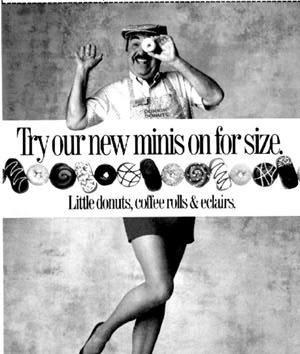
Figure 3
It
seems a waste to limit the
scope of transvestism to
critical meditations and mediations of examples such
as the Dunkin Donuts ad in Figure 3 where corporate culture oddly
mixes
classical notions of the chimaera with a denuded,
valorized
visioning of a cross-dressing male.

Figure 4
source:
http://web.actwin.com/toaph/peewee/peewee.html
Let us
move from the abstract to
the specific enigma that is Pee-wee Herman: Paul Reubens (aka Pee-wee
Herman)
is a man dressed as a boy; or, to be more specific, Paul Reubens is a
male
actor impersonating the character of a boy dressing as a man; or, even
more
specifically, the character of a boy dressed how parents, or other like
adults,
might dress a boy they wanted to look like a man. Reubens does not
change
clothes to embody the character of another gender, but to affect the
personage
of another age, another mindset, a man dressed as a child might who
wanted to
look like a man. This, then, I read as a radical form of transvestism
which
sentinels of cultural standards found hard to countersign. Those
familiar with
Mexican television know the pleasures of watching a man dressing and
performing
as a boy is not limited to the rarified television-rich atmosphere of
the
United States.

FIGURE 5
source:
http://www.chespirito.com/elchavo.htm
Mexican
television's El chavo
del ocho/The Boy from the Eighth Floor is another example.
Here an
actor known as "Chespirito," born into this world as Roberto G—mez
Bola–os, now past seventy, plays a pun-loving, mischievous,
impoverished
child, the bane of the low-income, high-rise neighborhood within which
he
dwells and the show is set.
What a
curious theatrical desire,
both peculiar and provocative: a man dresses and acts as a boy. For a
boy? For
boys? and what of girls? The Mexican actor who plays el chavo del
ocho is seventy, Paul
Reubens was
still playing Pee-wee in his late thirties and now, past 51, is
considering
re-enacting his singular role. What of Bob Denver, aka the dopey
indeterminately adolescent Gilligan, is he, too, part of this
phenomena?
I am
not alone in my suspicion
regarding global, critical deployments of the transvestite concept, as
I have
been guided in my efforts by the works of the late Cuban exile, Severo
Sarduy.[12] In "Copy/Simulacrum,"
Sarduy develops his theory of transvestism, building upon the work of
Roger
Callois in a study of camouflage. Sarduy does not read
transvestites as men who want to look like women, but as individuals
who assume
the exaggerated guise of the other gender so as to disappear: "nothing
insures that the chemical--or surgical--conversion of men into
women does
not have as its hidden goal a kind of disappearance, invisibility, effacement"(94). In "Toward a
Hypertelic Art," Sarduy expands this view: "Camouflage: not to seem
the aggressor. Not to have to defend oneself. To counteract the
enemy's
scrutinizing eye by resorting to an apotropaic death: theater of
invisibility"(95). In the end, Sarduy fashions a "law of true
disguise" so as to better render the nexus of desires and acts at the
heart of transvestism. Not as an act with a goal, nothing so
economically
practical, but as an example of performance without end:
performance in
the interest of performance.
In a
Western context so
thoroughly saturated with a psychoanalytically informed and
existentially
motivated view of Identity and the self, shape-shifting entities
like the
transvestite, or, like the actor who assumes an alter/ego of a child
masquerading as a man, are sure to call into question the very
foundations
of the state, of the social body that believes the reflection it
fashions for
itself in the mirror of mass culture. In his succinct, probing
introduction to
the memoir of Herculine Barbin, Michel Foucault ironically queries "Do
we truly need a true sex? With a
persistence the
borders on stubbornness, modern Western societies have answered in the
affirmative."[13] Three pages later
Foucault
remarks, "At the bottom of sex, is truth." It goes without saying
that the
categories of Self and Truth share turf when one examines the ideology
of the
West. Gender, too, is in there also and all this comes to a head, sort
of
speak, with the sad, titillating case of Paul Reubens.
Scene
Four | Saturday Morning Rogues, Innocent Family Situation Comedies and
a
Singular Transsexual
Let us
begin again--"begin
the begin." And let us talk about the difficulty of talking to each other without
talking at each other. Can we
even speak of
each other, of the "other?" My designated academic specialty is as a
theorist of Chicano/a and Latin American culture. Chicano/a and Latino
artifacts line my office, analyses of the same decorate my vitae. So
this,
then, is my turf. But if you were going to graduate school as I was in
the
mid-1980s, you could not overlook, unless purposely or genetically
thoughtless,
the determinant and indeterminate findings that were beginning to
accrue and
now prosper under the rubric of gender studies.
I have
recently been engaged in
the critical examination of Latinos and Latinas in United States mass
culture,
and Warner Brothers ubiquitous rodent, Speedy Gonzales, has been very
much on
my mind of late.[14] It was, in fact, my
interest
in Speedy Gonzales that led a would-be specialist on Latin American
literature
and culture to the rather alien terrain of Saturday morning children's
television celebrities, to Pee-wee, and, as we will see to father/other
figures
on the Brady Bunch television series. What
yokes Speedy and Pee-wee together is their
audience--by and large
these are moving picture entertainments for children and young adults;
but what
makes them blood brothers of sorts is that they are both highly sexed
and
sexualized. In these entertainments and in the controversies
surrounding their
real-life pupperteer/creators, we are presented with modern-day
parables
wherein revelations regarding diverse ideological constructs abound.[15] Speedy Gonzales
entertainments
ask viewers to navigate the ever-bumpy terrain of ethnic stereotypes,
Latino
masculinity, 'swarthy' machismo, as well as the processes which
naturalize
heterosexual rakishness as the signature of Latino desire. All are
readily
apparent in the images here for your perusal.

from Tabasco Road
directed by Robert McKimson, 1957

Fig 7 Mexicans in Trash
from Cannery Woe

Figure 8 Chick Inspector
I grew
up, as most of you did,
with Speedy Gonzales. It is only recently that I have begun to assess
the
magnitude of the marks this particular piece of animated vermin
has
tattooed across the body of my psyche, the psyches of all who have
witnessed
his clever antics.
As we
dally here momentarily with
the Warner Brothers's redoubtable rodent we are not so far afield
with our more
general concern with transvestism and an oddly and highly sexualized
children's
television star. For a whole generation of American television viewers,
Warner
Brother Cartoons defined Saturday Morning television, moving amidst
CBS, NBC,
and ABC Television in the from the 60s to the 90s. And discussions of
Speedy
are not extraneous to concerns with archetypal sexuality: Speedy
typifies the
Latino "macho" who, as Sarduy has ably suggested in his reading of
JosŽ Donoso's, El lugar sin l’mites /The Place that has no Limits, is "incapable of
confronting his own desire, of assuming the image of himself
imposed by
that desire, the macho--a transvestite in reverse--becomes an
inquisitor, an
executioner" ("Writing/Transvestism," 34, emphasis added). The
step between costume and language, subjectivity and mother tongue is
here a
rather short one: a "space of conversions, of transformations and
disguises: the space of language"(35). Sarduy's words here allow us to
suture together our concern with celebrity and innocence, transvestism
and
resistance to the phenomena of transvestism by mass culture.
We have
another television icon
to consult before we return to watching Pee-wee Herman watch, to
watching
others watching others watching Pee-wee Herman watch. It begins
innocently
enough with the image in front of you--a somewhat familiar shot of
nine,
black-bordered cells; each cell, in turn showcasing two divorced,
remarried parents, one cheery domestic servant and six children.
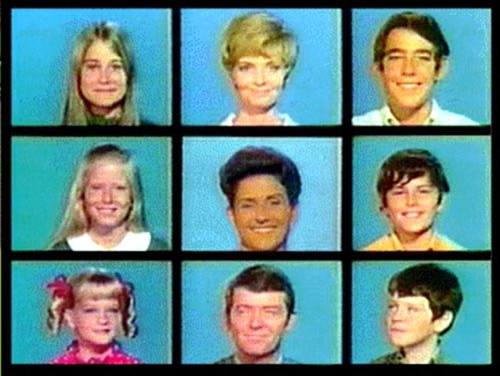
Figure 9
Readers
chained in Plato's cave
since the Seventies, won't have a clue that the image is culled from
the
opening credit sequence of an ABC television series, The Brady
Bunch.[16] These images, in
particular the
bottom center image of beneficently smiling Patriarch/Daddy Mike Brady,
are to
be held in the foreground of your consciousness, held in reserve
as it were,
so as to prepare you for the next set of images to follow.
Without giving away too much, I will
only add that if you ever watched The Brady Bunch, that
quasi-mythological grand
narrative of a post-divorce, reconstituted American nuclear family,
that
epitome of cold war age suburbia, you may be in for a bit of a
surprise.
In
front of you now is a black
and white still image from a made-for-television movie-length special
episode
of another 1970s television series entitled Medical Center--this particular
episode tellingly
entitled, The Fourth Sex. In this
momentous piece of late twentieth century
tele-cinema, we are confronted with the tragic dilemma of one Dr.
Patrick
Gaddison. Pat's doctor and friend,
"Joe" (played with the thespian range of a rotting log by seventies
"hunk" Chad Everett), has just informed "Pat" that a
"four-hour procedure" on the operating table awaits him.
The
operation?
"Pat"
wants to become
"Patricia." No mere transvestite, Dr. Pat[ricia] yearns to change
more than just his clothes. In the scene, here reproduced, Pat
appoaches
the soon to be spectre of his male self in the mirror.
There he pauses to deliver a simple,
poignant line with conviction: "Goodbye, Patrick James Gaddison."
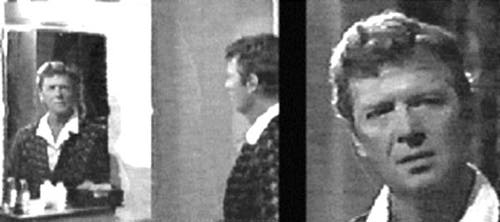
Figure 10
Patrick Gaddison
confronts his
mirror, confronts a version of himself in a special two hour episode of
the CBS
series, Medical Center.
Pat and
Patricia Gaddison is
played to the hilt with melodramatic adroitness by Robert Reed. Yes that
Robert Reed, the very
same actor
who developed the character of Mike Brady, the Kronus of gated
California
sprawl of The Brady Bunch. In The
Fourth Sex however, this special
award-winning TV movie (Robert Reed won the Emmy in 1976 for
outstanding actor
in a television drama), one encounters the paterfamilias of the Brady clan as
never seen
before. Needless to say, Pat's
alteration into Patricia comes as a bit of a shock to his wife Heather
and
their baseball-loving son, Steve.
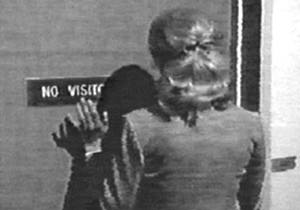
Figure 11
"No
visitors" glares
the sign. Patricias "wife" Heather confronts that bar, having
just removed her wedding ring and glancing at her nails as if
anticipating some
odd, uncanny encounter that will challenge her gender identifications,
an
rendezvous that is somehow anathema to the institution of marriage--for
how can
Heather be married to Patricia?
Ignoring
the bar, the sign which
forbids entry to the "freak" within, she braces herself for her
encounter with her "husband." The camera lingers on the actress's
back as she slowly approaches the hospital room portal--a one-way door
that
forbids the solace of a return. It is at this highly charged encounter
that
Patricia, complaining of scores of unanticipated visitors, mouthes the
words
which appeared at the head of this essay: "If one more person comes in
here
to take a peek, I am going to charge admission."

Figure 12
at the
time, Medical Center was
riding a wave of public
interest in the U.S. concerning those technological and procedural
advances in
the medical arts that allowed for men to "become" women; Pat/Patricia's
crisis was a thinly-veiled take on the then-breaking and landmark RenŽe
Richard's transsexual operation story.[17] And to their credit,
Director
Vincent Sherman's and writer Rita Lakin's The Fourth Sex, along with the not
inconsiderable thespian contributions of Robert Reed, achieved a
poignant
performative success on television in the mid-seventies.[18]
1975: a
year which witnessed the
incarceration of Nixon Watergate figures H. R. Haldeman, John Mitchell
and John
Erlichman, the capture of heiress/bank robber/terrorist diva Patty
Hearst and,
finally, the death of fascist wonderkund Generalisimo Francisco
Franco in
Spain. It also marked a turning point in the development of the critic
whose
words you are now reading here.
Scene
Five | An Autobiographical Intrusion
An
affable, if a bit peculiar,
husky, tele-addicted 13-year old teenager from Laredo, Texas with
limited
experience and even less insight, I remember laughing quite viciously
at the
spectacle of Pat/Patricia's conundrum--Pat's choice to go under the
knife and
emerge as Patricia left me in howling tears, doubled over at the, for
me,
ridiculousness of the situation--after all, this is 1975; The Brady
Bunch ended its series run
in 1974:
too much, too soon; Mike Brady in a dress, castrated, invaginated, me
13. It was all I could do not to urinate
in
my pants as I rolled convulsing on the shag carpet of my very American
living
room.
Speedy
Gonzales, too, was a
source of no little delight. Here, after all, was an animated,
facsimile
version of a world somewhat akin to the Mexican American domain of
South
Texas--the "Mexicans" in Speedy's world were familiar, or, at least
the accented English was familiar, the familiar being all that is
usually
necessary to deliver paroxysms of laughter from your average human
subject. I
was no different. I laughed at Speedy, at the trash, at the thieving ratoncitos, and at Pat--most
loudly at
Patricia nŽ Patrick James Gaddison.
And
today, some thirty years
later, I am perplexed with a nagging curiosity. I want to isolate
the
source of my glee; I want to touch the source of my wholesale delight
and
somehow document the mechanics of that laughter. I have not the
vocabulary to
address the source of my merriment. This return is not to enforce upon
my past
guilt for acts I would now not think to perpetrate.
This essay is not a mere exercise in
recuperative nostalgia; It is to try to reconstruct the culturally
disseminated rewards that rendered sexualized acts of transition
laughable. Transexualism is not
identical to
Transvestism, but there is in the medical procedure an echo of the
dynamics of
the costumed act.
All of
which reminds me of an
anecdote a friend of mine from Laredo, Sandra Juarez,
told me.[19] A couple of years
back, Sandra,
then 22, made friends with an eccentric woman in the bordertown of
Laredo where
she and I were born and raised. For this telling, we'll call her Diana. Sandra and this
twenty-nine
year old woman named Diana became friends, close friends, over a series
of
weeks. One night, Diana drew close to Sandra and confessed that she was
a
hermaphrodite as she/he attempted to grope and snag a kiss. Sandra was
taken
aback, more from the novelty of kissing her "female" friend than by
Diana's hermaphrodite status--for Sandra had no idea what a
hermaphrodite
was.
She had never heard of, nor had imagined the possibility. As these
things
sometimes go, even for those of us with only one set of genitals,
no
romance ensued from Diana's advance and Sandra asked to go home. End of
anecdote.
What
matters about this minor
tale is not the sordid allure of scandal or romance, the Herculine
Barbin-like potential for taboo libidinal intrigue.[20] What matters is the
encounter
with that for which there is no prior model. Nothing in Laredo, her
education
or her experience had prepared Sandra for this situation. Her
perplexity,
and honesty about her perplexity I might add, underwrites much of
what has
here passed and what will herein follow: transvestites, transsexuals,
hermaphrodites, as culturally intriguing, 'anomalies' which carry the
mark of
difference within and, sometimes, without--differences which bring
into
high relief the conforming strategies of the status quo.
Perhaps
it is my dual imprinting
between rakish, macho Speedy and the revised body politics of Mike
Brady
reborn as a woman named Patricia, yes perhaps it is this twin set of
boundaries
which led me to seriously think through journalistic accounts of the
"scandal" of Paul Reuben's walking into a Sarisota Florida porn movie
house and allegedly masturbating, or "masterbating" (sic) as the
voyeuristic Florida security forces wrote it in their arrest
report.
And so
it concludes with this:
everyone wants to be moved by what they see.
An
alternative take? Everyone will
be touched by what they see.
Scene
Six | Watching Journalists Watch Pee-wee Watch
Our
locale and Modus operandi shifts
somewhat: where
transvestism and Saturday Morning celebrity have been our subjects,
surveillance now comes to the fore and dominates, as we move to a tale
of
dueling glances and of actions taken as a result of what was seen. So
let us
move 1
days after the feast day of image-worshipping Saint John Damascene, and to the journalistic aftermath of the events of the evening of 26, July 1991, and let us see what our colleagues in the yellow press had to say about the events of that evening.
July
31, 1991 | It is five days
after the capture and Joel Achenbach's story in The Washington Post opens quickly and
succinctly:
"Paul Reubens is living out every man's and every boy's worst
nightmare.
He is alleged to have been seen touching himself."[21] Achenbach's words
strike the
voyeuristic keynote that will typify media coverage of Reubens's
sex act.
Interestingly, Achenbach's piece finds him dismayed by the work of
his
journalist colleagues, lamenting how "the simple equation of fame plus
alleged sex crime equals news[,] requir[ing] ... the entire clammy
story be
exposed to the world." Refreshingly acute, Achenbach's sarcasm
cuts
to the quick: "there were no witnesses to the event other than one of
the
undercover officers assigned to stake out the theater--masturbation is
apparently
such a grave public threat in Sarasota that the Sheriff's Office
assigned
not one but three detectives to infiltrate the place and watch for
flapping
elbows
(emphasis added, B1; B9). In addition to clear editorializing,
Achenbach's
round-up gives us the straight facts, noting Reubens was detained
for acts
"in violation of Florida statute 800.03, Exposure of Sexual
Organs"--a personal behavioral choice that exacts a price municipal
price:
it costs Mr. Reubens "$219.00" to post bond. Achenbach's piece is
quite good and includes a highly entertaining if brief, thumbnail
sketch of the
history of attempts to eradicate masturbation from Samuel Pepys to
Sigmund
Freud, concluding quite evocatively, and even, perhaps,
autobiographically that
masturbation "is universally practiced, and it is
universally
considered vile"(emphasis added). In his final thoughts, Achenbach
muses
upon "people cast[ing] a jaundiced eyed at any adult who makes a living
around children."(B9). The Associated Press, perhaps fearing the
repercussions of said jaundice, were hot to the wire the very same day
as
Achenbach's Washington Post piece
with an unattributed sidebar
to the
burgeoning Pee-wee story: "How to Explain Pee-wee Herman's Arrest to
Children." The highlight of this brief journalistic vignette is a quote
from a Professor Jeffrey Derevensky of McGill University who passes
along these bon mots for
parents to pass on to their young children concerning the recent
exploits of
their "TV pal." Derevensky: You are to say Pee-wee Herman "was
doing things that were inappropriate. He went to a place that Pee-wee
Herman
shouldn't have gone to and he did something wrong." Other social
scientist
pundits are called upon in this AP wire guide to explain adult sexual
predilections to pre-school children. Elissa Benedek, a clinical
professor of
psychiatry at the University of Michigan Medical Center, offering
helpfully
that "parents should distinguish between Reubens the actor and Herman
the
character even when a child is as young as 3 or 4." Benedek's own
psychological condition comes into question, however, in her
conclusions:
"It is important to teach youngsters that what they see on television
is
make-believe, other than on the news"(B5, emphasis added).
Needless to say Benedek's implied faith in Rather, Brokaw, Jennings et
al.
ought to have given her readers (including three and four year olds)
pause.
August
1, 1991 | Daniel Cerone
and Alan Citron's piece in The Los Angeles Times appears and
attemptes to
measure the West Coast zeitgeist regarding Paul Reubens's
movie-watching
activities, citing this noteworthy pronouncement from the mouth of
local KCBS
tele-anchor Michael Tuck: " 'It's almost like Donald Duck flashing in a
public park'."[22] Tuck, who identifies
himself as
a "disappointed Pee-wee Herman fan," here invokes the holy name of
Disney via analogy, underscoring the severity of Reuben's act--in
Southern
California there are few more sacrosanct categories than Disney.
Tuck's
lament signals the outrage which attaches to the spectacle of a sacred
image
fouling itself. Auto-erotism and career suicide are revealed as
synonymous.
In the
articles that continue to
appear on a daily basis in newspapers and magazines across the U.S.
(echoing, I
might add, the semiotic wisdom of Saint John Damascene), Hollywood
producers
and industry pundits repeatedly allude to mention the mug shots of
Reubens
after his arrest which were run on television and the print media.

Figure 13
Ultimately,
the appeal and
pleasure of iconic juxtaposition ends up fueling much of the publicity.
Sally
Jessy Raphael
producer Burt Dubrow's 'eloquent' observation is typical: "it really
freaked us out when we saw the picture, because it was so opposite
from
what we know of him"(F10). New York Post metropolitan editor,
Hohn Cotter
explaining his none-too-subtle tabloid's attraction to the story
which
they ran page 1 is clear about the draw: "the mug shots were definitely
the
thing that grabbed us"(F10).
August
3, 1991 | In the days
after the arrest, more and more stories began to appear regarding the
slim
celebrity's sexual scandal. Lost in all the mud was a small notice in The
New York Times regarding
an old friend of Reubens in the Sarasota Sheriff's Department who tried
to lend
Pee-wee a hand.[23] Corporal Joan Verizzo
"will
be suspended for a day without pay for helping to provide bail money
for the
actor Pee-wee Herman, a longtime friend." Here is a narrative rift with
real
intrigue--signaling a minute fracture in the order of the policing
institution
charged with Reuben's prosecution, the Sarasota Sheriff's Department.
More on
this suggestive schism below.
August
5, 1991 | The scandal
continues to snowball, with the effects of Reubens alleged public sex act
rippling
throughout the entertainment industry and business community:
David
Kilburn's "Sayonara Pee-wee" in the August 5, 1991 edition of Advertising
Age
explores the immediate, Multinational economic implications of a
masturbating
Reubens. Kilburn's blurb notes that a Japanese corporation, Wako
Securities,
has suspended Reubens's commercials until the case could be heard. The
ad firm
responsible for the production of this publicity series has a nose for
Western
sex scandals it would seem, having also hired Rob Lowe for earlier ads
which
had to be pulled from the airwaves lest Wako's face be lost in the
process(3).[24]
August
6, 1991 | The shit really
hits the fan when the mother of all newspapers on the mother of all
editorial
pages weighs in with its own less-than-mother-like (unless one's mother
was a
sociopath), pithy judgement. So it is that on this day, The New
York Times, in an unsigned
editorial entitled
"Sick Jokes," holds forth below stolid editorial pieces on
worker rights and the politics of embryos: "There seems to be little
doubt
that Paul Reubens, the actor who created Pee-wee Herman, violated the
special
standard that society rightly imposes on personalities of the
world of
children"(A16). This unelaborated "special standard" is of
course the ideologically inculcated values whereby sites and methods of
sexual
pleasure are collectively legislated and regulated. Needless to say, The
New
York Times
is responsible along with the broadcast networks for a fair share of
this
elided, yet essential, cultural legislation.
August
12, 1991 | Time
Magazine finally
weighs in with its comprehensive account of Reuben's epic sexual act.
The
graphic juxtaposition they include with their article speaks volumes--a
terse
iconic shorthand, and a nice counterpart to The New York Post editor's huzzahs
cited above:

Figure 14 [25]
Writer
Paul Gray's view of
Pee-wee is as curious and extraordinary as the noted graphics. Finding
that
Reuben's "hyperkinetic nerdiness was irresistible to millions of
children," Gray muses, ÒPee-wee Herman was a grownup version of
little
brother: winsome, goofy, capable of saying dumb things and
beatifically
happy with the panorama of the world . . . This man-boy with the tight
suit,
googly eyes and lipsticked mouth was not every parent's cup of tea: add
a leer
and the little guy could pass for the emcee of a Berlin nightclub circa
1935.Ó
Here, Gray aptly unravels the semiotic complexity of Pee-wee's routine.
As we
will see below, the particular aesthetic vein Reubens mined as Pee-wee
has its
roots in a realm of sexual desires and practices perfectly suited to
outrage
guardians of our domestic cultural status quo. Gray's conclusion is
equally
acute: "Perhaps the real crime, the one for which Reubens has been so
relentlessly pilloried, was the successful pretense of
childishness."
I read Gray's finding here literally: adults really do derive no little
satisfaction from the pillory of others for the exploration of
sexual
pleasures allowable in toddlers and infants (if then!). In short, much
of the
public spanking Pee-wee received may profitably be read as a mass
cultural
castigation for the particular flavor of "entertainment" his Saturday
Morning television show, stage act and holiday specials embodied.
August
12, 1991 | The highlight
of Charles Leerhsen Newsweek Magazine piece is the following
loaded,
not-so-rhetorical question: "Can an electronic babysitter violate our
children's trust?"(54) The image of a babysitter masturbating at the
local
porn-house inflames the always already heady mix of celebrity and
scandal surrounding
Pee-wee Herman's situation. Leerhsen's essay adds a few tidbits
regarding
the circumstances of Reubens's arrest: "The undercover detectives were
said to be working on a drug case, and when their leads did not pan
out, they
decided to check the theater for sex offenders"(55). That the agents
charged with maintaining Sarasota's public hygiene move so easily from
narcotics
stake-out to porn-house surveillance speaks less to their particular
range as
detectives, I suspect, and more to the boredom of under-educated law
enforcement types out for a good time and a little work on the side.
The
denouement of this particular Newsweek story is memorable: a
quote from
a professor emeritus of children's shows, one-time celebrity Soupy
Sales, who
weighs in with this bit of sage advise for Mr. Reubens: "He can
masturbate
his brains out, but you don't do that in a porno theater when you're a
role
model"(55).
August
14, 1991 | A memorable Wall Street
Journal op-ed piece ("Pee-wee
Herman, Hero of the Hour") by Doy Aharoni appears. Aharonia, a rabbi,
author and student at the UCLA School of Law, discloses a bit of
cultural study
minutia which actually solicits and licenses a return to the work of
Severo
Sarduy noted above in our discussion of transvestite dynamics.
Aharoni's
sympathetic piece notes that among the many project cancellations
endured by
Reubens (the remaining episodes of his CBS Saturday Morning television
program,
advertising and promotion contracts etc), "the Philadelphia Zoo has
zapped
[their] two minute Pee-wee flick, this one explaining metamorphosis and
starring a butterfly and a caterpillar."[26] The irony of this
cancellation
in the context of our inquiry is not to be missed: ultimately, this
study
submits that Paul Reubens was punished in the media for, among
other
things, embodying a flexible subjectivity--an existentially charmed
entity or,
even, organism that sanctioned flexible gender and sexual practice
oscillations. Reubens's invention
of a character who wears the costume of a boy dressed as a man has been
revealed here as a striking alternative form of transvestism--here, the
transvestism in
question being understood as
one which operates not strictly with regard to gender (as opposed to
Eonism)
but also with regard to age: an actor camouflaged as a child
camouflaged as a
man. The irony of a zoo's decision to excise a two-minute short film on
insect
metamorphosis comes into high relief in a discussion of transvestism
informed
by Severo Sarduy theorization of the same: Reubens had completed a
short
informational film about the transformation of caterpillars into
butterflies--an
animal kingdom transformation, as documented by Sarduy via Roger
Callois, which
provides an analogue to human costuming strategies. As Sarduy concludes
in
"Copy/Simulacrum": "the animal-transvestite does not seek a
friendly appearance in order to attract (nor a disagreeable appearance
in order
to dissuade), but an embodiment of fixity in order to disappear"(94).[27] More generally,
Sarduy uses
these views in order to sustain his striking revelations
concerning the
relation between behavior and rhetoric, culture and narration: "Transvestism...may
well be the best metaphor for writing .. . mak[ing] us see. . . not a
woman who
might be hiding a man beneath her appearance..., but the very fact of
transvestism itself"
("Writing /Transvestism," 37).
August
19, 1991 | It is now over
three weeks since the story broke and Fred Barnes et al. in The New
Republic seem
at first to strike a sympathetic stance of advocacy on the whole issue
of
Pee-wee's incarceration: "The question to be asked is not why Pee Wee
(sic) Herman was allegedly masturbating in an X-rated movie house
(arresting
him for such is like arresting someone for drinking in a bar) but
rather why
the police were sweeping the aisles with flashlights in the first
place. If
there is any indecency to expose, it's the prurience of the police, and
the
cowardice of CBS."[28] A laudable view, but
before we
acclaim the courage of NR's editors, let us take a closer look at the
odd
opening sequence which precedes their defense: "Free Pee Wee (sic)
¦The
appearance of children's television star Paul Reubens...on the
cover of
Tuesday's New York Post was, to
some, a myth-shattering revelation. Reuben's mug
shot after being arrested for indecent exposure in a Sarasota, Florida
porno
theater was a far cry from his rosy-cheeked, asexual on-camera
persona"(emphasis
added, 10). "Asexual"? Pee-wee Herman? I do not think the semantic
contours of the term asexual ("adj 1: lacking sex or functional sexual
organs. 2: produced without sexual action or differentiation") can
be
of any use to our survey. An unusual and untenable premise;
consider the
alternative: It is, in fact, the particular form of Pee-wee Herman's
overlooked
and highly sexualized popular subjectivity which will, in fact,
underwrite the
scandal which arises from his public sex act.
November
6, 1991 | Weeks after
Reubens' brief imprisonment, Daniel Cerone was back writing in The
Los
Angeles Times
documenting the judicial end of the Pee-wee sex drama: "Paul Reubens
will
plead no contest to a misdemeanor charge of indecent exposure...The
deal was offered last week, it appears, after Reuben's lawyers showed
the court
a videotape from a surveillance camera in the adult movie theater that
allegedly supported Reuben's claim of innocence"(emphasis added).[29] Talk
about a late-breaking ironic scenario. In the final
weeks of a case that allegorically fuses together all sorts of late
20th
century concerns with voyeurism, identity, sexuality, and subjectivity,
the
star witness for the defense is an unseen VHS surveillance camera in
the garish
lobby of a fateful Sarasota porn-house. The break "came October 7"
relates Cerone, "when lawyers representing Reubens disclosed to the
prosecution a videotape shot by a security camera in the lobby of the
theater
on the night of the arrest. According to Dresnick [Ron Dresnick, one of
Reuben's attorneys], the time code on the videotape showed that
Reubens was
in the lobby when detective William Walters allegedly saw the actor
masturbating"
(emphasis added). The human detective/voyeur's testimony is at odds
another
star witness/voyeur, this one non-human, a camera. "Walters
claimed
in a deposition that he had constant watch over a man he alleges was
Reubens
for a 20-minute period in the theater. Halfway through that time frame,
however, is when Reubens was videotaped in the lobby" by his friend, a
camera.
I am at
great pains to resist
anthropomorphizing this Pee-wee friendly camera, to personalize it like
Chairie, and Globie, and have it sassy-mouthed and irreverent, chiming
in with
its findings in the final hours, affording Pee-wee a last minute
reprieve from
hard time in Sing Sing.
Pee-wee's
lawyer Dresnick's
conclusions, are, in the light of the scenario previous, kind of
pedestrian, but their political economic implications are
nonetheless
worth sampling. Recalling the Los Angeles Rodney King tape evidence
controversy, Dresnick waxes semiotic: "It's a perfect example of the
power
of the videotape recorder, where police just don't have any idea who's
watching
them." This documentation of surveillance and the police in the context
of
sexuality sanctions an introduction of thoughts from the late-lamented,
oft-cited French scribe Michel Foucault: "With these themes of
surveillance, and especially in the schools, it seems that control over
sexuality becomes inscribed in architecture. In the Military
Schools, the
very walls speak the struggle against homosexuality and
masturbation."[30] The irony here?
Reubens was
incarcerated for lewd acts upon his person in a structure
architecturally
designed to provoke masturbation. Akin
to a dark waking dream
space, the site of the motion picture theater seems designed by
the likes
of a Bentham for the pleasure of the seated voyeur. The antithesis of a
panopticon prison, the movie house seems the perfect place to "flap
[one's] elbow" with impunity. Who would imagine that a palace designed
for
the delights of the watcher would solicit the policing gaze of
Sarasota
sheriffs. In our every day waking, walking public lives, policing
agencies and
public institutions have "no need for arms, physical violence,
material constraints. Just a gaze. An inspecting gaze, a gaze which
each
individual under its weight will end by interiorizing to the point that
he is
his own overseer, each individual thus exercising their surveillance
over, and
against, himself"(Foucault, 155).[31]


Figure 15
A modest shot of
Sandra Scream,
one of the actors whose onscreen exploits moved Mr. Reubens that
fateful night
in Florida.[32]
But a
movie house is
different--akin to the bedroom or toilet, a movie house seems that most
remote
island of privacy. Hence the irony of the public spectacle which comes
to
surround Paul ReubensÕs private screening of Nancy Nurse starring Sandra
Scream, Turn
up the Heat,
and Tiger Shark in
the South Trail Cinema.
Scene
7 | Spanking the Gender-Bending Prankster
This is
an informed chat. A
thinking through. I am sharing some recent findings, initial but
well-worked through--more a deck of cards than a road map. So we have
watched
journalists watching, amused ourselves with the sometime apt,
sometimes
annoying perambulations from the worlds of newspapers. Now it is
time to
come clean. Cultural commentators, academic cultural workers, what can
we add
to the discussion that might take us outside this circuit of scandal,
disappointment and banal outrage.[33]
When I
shared this chat at UC
Davis, I was in the initial moments of thinking through Thomas
Laqueur's Making
Sex: Body and Gender from the Greeks to Freud and its well-crafted
take on the
one sex/two sex debates on sexual difference--a volume that is worth
the price
of admission if only for its selective art historical survey on the
aesthetics
and sexual politics of anatomy illustration. So now it is with mild
trepidation
that I move to a mild rebuke of some choice words drawn from Thomas
Laqueur's
book.
Trepidation
not because of the
esteem which has accrued upon Laqueur's project, but for from where it
is
drawn: his conclusion. Rhetorically speaking, conclusions are odd,
anxious
sites, the desire for closure running head long up against a critic's
desire to
analyze, to break things down--my own piece will cop-out with a
Post-script in
lieu of a conclusion, which introduces attendant complications of its
own.
Here
then, in his denouement,
Laqueur writes "...the content of talk about sexual difference is
unfettered by fact, and is as free as mind's play..."[34] We can intuit
Laqueur's goal in
these lines, crafting a thesis about the cultural construction of
gender
roles, not to mention gender costumes (two different beasties if you
ask me);
Laqueur wants to stress the openendedness of it all, how having
acknowledged
the constructedness of men and women, of bodies designated male and
female, we
can now critically walk past that limited binary view and throw
ourselves
(rhetorically?) into the churning polymorphous waters of life.
Leaving
aside my cynical suspicion that while lunching at the Plaza, Laqueur
uses the
men's room, I merely want to re-emphasize that we would do well to
sidestep the
issue of freedom with regard to the content of our talk. To talk is to
be
fettered, and to imagine otherwise a naive dream.
In this
essay, I would like to
translate Laqueur's critical architecture and try to imagine infants,
kids,
teenagers, adults, and the elderly as categories much akin to those
associated
with gender. Sex practices and taboos also figure in and intersect
these age
categories. While it is perfectly acceptable for an eight month old
male infant
to publicly hold and manipulate his genitalia, a thirty-nine year old
male in a
public theater will have a tougher go of it. Once a community brings
these
age-sensitive categories online, they are quietly and powerfully
naturalized,
and the stage is set for all manner of neuroses. I
am not being obtuse or abstract: one has only to mention
the specter of the pederast to kindle the outrage of the masses.
And part
of the controversy surrounding the 'scandal' of Paul Reubens's sex
act
derives from the fact that he produced a program ostensibly designed
for
children; that he dressed, singularly, as a child, and that he
pleasured
himself sexually.
And I
think it is time to allow Paul
Reubens to weigh in on his own behalf. As I suggested above, I read the
vehemence of the response against Pee-wee and his private sexual act in
a
public venue (the cancellation of multi-million dollar ad
accounts,
neighborhood Pee-wee impersonators out of a job, the network
cancellation
of his remaining shows) as a collective vote of sorts, on the part of a
significant, determining minority. This vote, the equivalent of a slap
in the
face or boot in the ass, amounts to a public spanking of Pee-wee for
his
misbehavior: namely his nationally televised showcasing of
gender-bending
celebrities. We can account for the scandal, but not the glee of the
media.
What had Pee-wee done? What had his productions perpetrated on the
American
masses to deserve such a public caning.
To
begin to answer these queries,
let us screen a few frames culled from a Pee-wee's Playhouse X-mas
Special (1987) directed by
Paul Reubens
with Wayne Orr and written by Reubens with John Paragon. In these
images one
confronts status-quo gender propriety subjected to ironic and
subversive
parody--campy, irreverent and, in my view, delicious. The vehemence of
the
mainstream media's response may be read then as a rebuke for this
boy/man/comic/trickster not playing by the stagnant, concrete rules of
identity
and sexual choice. Consider only this: in his singular special,
Reuben's and
his coterie of actors, artists and producers, attack for comic profit
that most
sacred of Christian and Capitalist holy days--Christmas. December 25:
both the ostensible
birthday of Jesus Christ and that
consumber frenzy season most associated as a tonic
for Capitalism--the Christmas buying season. One would have to search
long and
hard for more important totems in US mass culture. I don't imagine I
will have
to provide you with a slew of citations from sociologists and
anthropologists
on the topic of Christmas and holiday rituals in order to sway you to
my view
of things on this issue. That all of Christianity and all of the retail
barons
of Wall Street and the European Commonwealth celebrate equally the
glorious
rituals of worship and purchase that is Christmas hardly calls for
concrete
substantiation.
And it
is with the particular
genre of the child's Christmas television special that Pee-wee Herman
elects to
launch his campy satire. A domain best known for the likes of Rudolph
the Red
Nose Reindeer, Frosty the Snowman, and Charlie Brown, the Christmas
season
television line-up is a paean to the spirit of Christmas past, those
pre-secular days of lore when Christ was born and gifts were exchanged
and
children rubbed their eager noses on windows scouting for reindeer and
an
overweight, if generous, strange man's largesse. As I argued in my
"Autopsy of a Rat," even when the characters are downright cruel
(viz. Dr. Seuss's Grinch and ol' man Dickens' Ebeneezer Scrooge), their
malevolence is merely a pretense for their ultimate redemption in the
final
act.
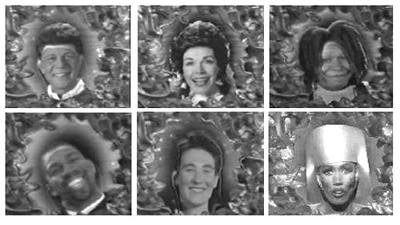
Figure 16
Panoply of Camp Stars
Nothing
so contrived is to be
found within the confines of Pee-wee's Playhouse X-mas Special. The opening sequence
of the
program begins with a tracking shot of a line of elves throwing
extravagantly
decorated gifts down a snow-framed well, anything but an auspicious
beginning.
And we have not even mentioned yet the mischievous selections of
casting
director Diane Dimeo in pulling together her Multicultural,
multi-sexual,
polymorphously endowed company of players who visit Pee-wee for
Yuletide cheer.
This singular and provocative grouping merits a brief pictorial review;
it is a
veritable who's who of kitschy, camp, US celebrity including Frankie
Avalon,
Annette Funicello, Whoopi Goldberg, Earvin "Magic" Johnson and kd
lang. Note the juxtaposition of clean-cut X-mas symbolism (each star
ringed by
a holly wreath) with ironic camp lurking there on the fringes--Avalon,
lang and
Goldberg, the possibilities are endless.
The
Christmas Special's
boisterous opening song sequence, a Gene Kelly-style extravaganza that
begins
with the gift-down-the-well-throwing-elves animation, ends with a
stern
and sober company of what appear to be Marine Corps Honor Guard singers
solemnly and richly intoning a minor-chord heavy carol noting "It's
Christmas in the Playhouse."

Figure 17
Stern, solemn
Marines
This
almost sacred, somewhat
melancholic, interlude comes to what appears to be a closing pause when
Pee-wee
appears suddenly and the slow, dirge-like music suddenly bursts into a
rock'n'rolling melange of Busby Berkley and Esther Williams with
Pee-wee
leading his Marines-cum-Rockettes through a rousing song and dance
sequence
whose choreography is pure MGM.

Fig 18
Semper
Fi meets Esther Williams
The
flamboyant, knowing, camp
aesthetics of this performance is all the more ironic in
politico-sexual
context of recent controversies surrounding gay men and 'don't ask,
don't tell'
policies in the United States armed forces.[35] Needless to say, the
scene
experiences a bit of a climax when one of the crooning soldiers
gooses a
surprised and rather dismayed Mr. Herman.[36]
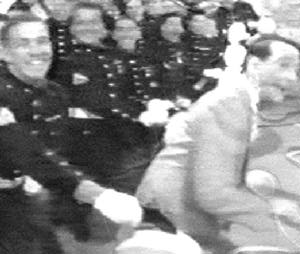
Figure 19
Marine playfully
gooses Pee-wee
After
Pee-wee et al.'s dazzling
opener, the special gets down to work with peripatetic glee: one
sub-plot
follows the running gag of Pee-wee's greed (a greed made all the more
acute by
the gift-potential of Christmas); another, is a curious vignette which
charts
Pee-wee's attempt to speak Spanish (feliz navidad in Pee-wee's mouth
becomes
"felesshh nabbaabbah") with a Latino dupe, Ricardo--a vignette which
ends with Ricardo approaching a festive pi–ata sequence. The
pi–ata skit,
is, itself, merely a set-up for a succinct paean to Hollywood Latinas
via
Dolores Del Rio/Lupe Velez simulacra, "Charo"--"Now the only
thing missing is Charo," Pee-wee exclaims.
Another
compelling vignette,
captures the late singer Dinah Shore, who had a sickeningly sweet
morning show
of her own at one point, singing the "Twelve Days of Christmas" to a
cruel Pee-wee via videophone. Pee-wee, annoyed with Shore's
interloping,
replaces himself with a masked mannequin, to whom Shore, oblivious,
addresses
her song. This is a text rife with semiotic possibility.
Simulacra,
automatons, the mask, television, the phone etc.
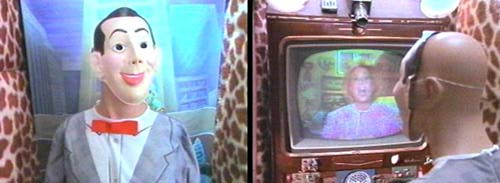
Figure 20
Dinah
& the Automaton
Dinah Shore sings "The
Twelve
Days of Christmas" to a mannequin.
Earlier
in the gala, Pee-wee has been
visited by New York City cabaret fixture Grace Jones who enters the
chez
Pee-wee via a sealed box, intended destination: The White House.
Just
before the crate Ms. Jones appears from is opened, Pee-wee says, "I
hope
it's not another fruitcake." The unsolicited, unwanted fruitcake is a
motif of the Christmas special, with guest after guest handing
ungrateful
Pee-wee Herman one of these peculiar holiday confections. An odd
overlap of
Christmas and Gay Male aesthetic here appears, the Yuletide
fruitcake
("fruitcake n. a rich cake containing nuts, dried or candied fruits,
and
spices.") also being a popular early 20th century English-language
epithet
for Gay males. This is not a hermeneutic stretch as any viewer of the
show
quickly gathers. The motif culminates in a topper of a vignette, late
in the
show.
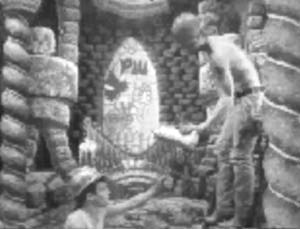
Figure 20 Pee-wee
& the
Fruitcake
The
walls of Pee-wee's Playhouse
part between reproductions of the da Vinci's Mona Lisa and Little Boy
Blue,
revealing a backroom with a wall of fruitcakes being assemble by two
beefy
construction worker types (Village People-style hunks). Pee-wee's
succinct
exchange with the sweaty shirtless laborer speaks reams: "Here's two
more
fruitcakes Roland."
But let
us return to Grace Jones
and her oddly appealing, disco-fied version of "The Little Drummer
Boy" with which she treats Pee-wee. Jones's version of the X-mas
classic
is like no other I have ever seen, the solemn tale of Christ's herald
reborn as
a modified striptease gyration
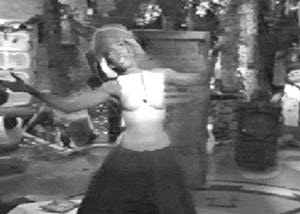
Figure 21 Grace Jones
Strips
In the
image, here reproduced,
you see the shadow of the gloves she has just flamboyantly hurled off
camera.).
When Jones intones, "I saved my best for him" we know we are not in
Santa's workshop anymore.
It is
the purpose of this essay
to suggest that sequences like this lead mainstream media pundits
to
discount and abuse the entertainments issued by Reubens and his camp;
the quote
which follows, pulled from the Newsweek piece cited above is typical:
"His
show was 'a gallery of weirdos,' says John Hannah, a Los Angeles writer
who
knew Reubens. 'A kind of surrealist bathhouse.'"(55) Given the
impact
of surrealism and by surrealists on the art and politics of the
twentieth
century, Hannah's remarks may be re-appropriated and championed as an
astute
anology. In the Newsweek piece cited above
(August 12,
1991), it merely served to underscore Reuben's allegiance to the domain
of gay
male aesthetics.
Scene
8 | Turn off the Cameras and Close Your Eyes
This,
then, has been a short
story about scandal. Recently, the number of scandals in the United
States mass
media has risen in direct proportion to the rise of what is called
"tabloid television"--Real Video, Hard Copy, Inside Edition, The World's
Wildest Police
Videos
and their ilk. Although they purport to take the pulse of the American
nation,
these "journalists" are more interested in profiting from a growing
hunger (nurturing it as the same time) for the titillation and
pleasure
(not to say profit) which derives from electronic voyeurism. Needless
to say
this has led to a reinforcement of some of the more retrograde US
"shared" cultural attitudes towards those whose sexual orientation or
practices are at odds with powerful fictional oddities of the late 20th
century
which go by the name of "family values."
This
essay, then, chronicles a
brief interlude in the history of surveillance and the policing of
those
values. Focusing primarily on the set of events surrounding the
arrest of
Paul Reubens in an X-rated movie house for public masturbation, it
deals
also with the status which attaches to the bodies and actions of
individuals
whose celebrity derives from the gaze of children. Citing various
resources
(Severo Sarduy, Roland Barthes among others) and media (newspaper
stories,
photography, and toys), I argue that part of the scandal which arose
from Mr.
Reuben's unfortunate incarceration derives in large part from the
nature of the
entertainment he had been producing for CBS during his reign at the
network. We
have just briefly peeked at parts of one of these entertainments.
Though
a Saturday morning
celebrity's encounter with cinema and some sheriffs provides the
centerpiece of this project, the essay also unfolds with some
institutional
goals attached. The piece attempts to build a bridge of sorts
between the
interests and practices of Ethnic American theorists and those
professionals
engaged in Gender and/or Gay Male and Lesbian Studies. Ultimately, via
Severo
Sarduy, I am attempting to fashion a speculation which might span the
concerns
of Chicano/Latino theory and Gender studies. And if I linger upon the
spectacle
of the cross-dressed subject, of transexualism on television, it is
because I
sense in these critical somatic interventions, an ally, or a means of
confluence with what Chicana theoretical diva Gloria Anzaldœa calls the
Mestizaje. This speaks to my
overall goal:
articulating recent American cultural trends with regard to the
intersect of
technology and desire--here film, sexual attitudes, surveillance
technology, and, what one might call, the pathology of celebrity are
all found
in bed together simultaneously.
Scene
10 | The Final Costume Change
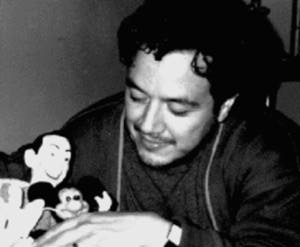
Figure 22
Pee-Wee & the
Author, San
Diego, 1994
In
dealing with the epidemic of
visibility menacing our entire culture today, we must, as Nietzsche
quite
correctly said, cultivate mendacious and deceptive
clear-sightedness.[37] So we have assayed
the
theoretical implications of Pee-wee Herman and the odd, moving tale of
a man
who profits by dressing as a boy dressed as a man. A television and
movie star who,
still on camera, bathed in the wondrous carnal entanglements of filmed
pornography, gets caught up in the gears of a cultural machinery
dedicated to
sexual policing, an embarrassing provocative tale of public outrage.
We have
spoken of spectators and
of surveillance--the dueling eyes of camera and detective. Desiring
detectives
wanting to see, and having satisfied that urge, acting on it after the
fact.
Our topics have spanned the gamut of cross-dressing, transexualism,
transvestism and hermaphrodites, a veritable hodge-podge of ostensibly
marginal
sexual subject position slots.
This
essay ends reflecting upon a
labyrinth of reflection: Paul Reubens returned to the silver
screen after
his masturbation scandal in the role of the Penguin's evil and
heartless father
in Batman Returns
(1992). The film, the second in the recent Batman series, was
directed by
Tim Burton, who also directed, more recently, Ed Wood a bio-documentary of a
famous bad
movie maker, and, not incidentally, a transvestite, played admirably
enough by
the somewhat handsome, always half-shaved Johnny Depp. One of Ed Wood's
first
feature films was Glen or Glenda (1953) also known as I
Led Two
Lives--the
movie poster promoting that film reappears here. In it I read an
compelling,
evocative visual counterpoint to the essay which now draws to a close.

Figure 23 Glen or
Glenda
Some
conclusions: Transvestites
are more than men who dress like women. Transvestites are less than men
who
dress like women. The ballad of "more irresolvable" is
irresolvable--shadows of the stagnant binary which embodies them,
resolution of
more or less is, in the end, meaningless. Transvestism is a process of
self-willed othering, of costume, and camouflage where the othered
subject
submits gender categories to that most acute analysis which, in the
theory of
comedy, is known as farce. Farce is serious business, as Freud, that
Viennese
author of psychoanalysis, was not the first to bring to light with his Jokes
and Their Relation to the Unconscious. So transvestites are
those who
dress as someone else, something other than who it is others suppose
them to
be, perhaps too other than who it is they themselves imagine themselves
to
be--Paul Reubens approximation of a spoiled child dressed as a
middle-aged used
car salesman is no less curious than Rue Paul, or Milton Berle for that
matter.
They are actors in masques that call into question the boundaries of
the real,
remarking upon it and challenging it in unmatched fashion through
unmatched
fashion. Ultimately, transvestites, acts of transvestism, reveal the
limitations
of the philosophical category of the existential. For that crime, their
trace
must be silenced, rendered farcical or be subjected to the eliding
ubiquity of
televised scandal.
Post-script, April 2004

In November of
2001, a search warrant was issued for the home of Paul Reubens in
connection
with another court caseÑthe object of this particular Los
Angeles City
Attorney-inspired safari? Child pornography.
Reubens understood right away the ramifications of the
search, stating, Òthe moment that I realized my name was going
to be said in
the same sentence as children and sex, that's really intense. That's
something
I knew from that very moment, whatever happens past that point,
something's out
there in the air that is really bad.[38] Though he
defended the collection as his vast and valuable historical
collection of
artwork, kitsch memorabilia and adult erotica, he ended up
pleading guilty to
the possession of obscene material to make the case go
away, to make these
particular cameras stop, so that the gaudy trappings of a
pederast's costume
might not be the final wardrobe change for the one and only Pee-wee
Herman. [39]
[1] Medical Center:
The Fourth Sex, CBS Television (1974).
[2]"How is the Liturgy
Celebrated: Signs and Symbols, Holy Images" Catechism of the
Catholic
Church Liguori,
MO: Liguori Publications for the Libreria Editrice Vaticana, 1994)
1159. The
quoted material within the epigraph derives from Saint John Damascene's
De
sacris imaginibus orationes 1, 16.
[3]As quoted in Charles
Leerhsen et
al. "'His Career is Over': Americans Couldn't Stop Talking About
Pee-wee
Herman's Sad Adventure," Newsweek (August 12, 1991),
54-55. The quoted material used
here to foreground the essay's title derives from a
statement made by Reubens's own
attorney in the days after the scandal broke.
[4]Curiously enough,
"dissemination" and dissimulation, ostensible homonymic antonyms, may
be used synonymously in the sentence previous.
[5]The Catholic
Encyclopedia,
Volume 6 ed.
Reverend Monsignor John H. Harrington (New York: McGraw-Hill
Book Company, 1965), 37.
[6]I have dealt with
related issues
at length in "Artif(r)acture: Virulent Pictures, Graphic Narrative and
the
Ideology of the Visual," Mosaic: Journal for the Interdisciplinary
Study of Literature,
28(4): (December 1995) 79-109. The work which appears here before
you owes
a deep debt to Toni Morrison's The Bluest Eye which I view to be as
moving and powerful a collection of
thoughts on the theorization of image technology as the Stephen Heath
et al.
edited issues of the journal Screen, and as John Berger et
al.'s groundbreaking volume
and television series for the BBC, Ways of Seeing. Using Morrison's
protagonist/narrator Claudia as a lens of sorts, I am enabled to
rethink
movies, toys and, by contiguity, Saturday morning children's
programming.
Those of you who have read Morrison's novel will recall the striking
sequence,
where Claudia MacTeer, perplexed as to the source of a white,
blond-haired dollÕs
ostensibly intrinsic "beauty," sets out to destroy the doll, to
analyze it literally, breaking it down into its constituent parts and
destroying the doll in the process: "Break off the tiny fingers, bend
the
flat feet, loosen the hair, twist the head around, and the thing made
one
sound--a sound they said was the sweet and plaintive cry 'Mama,' but
which
sounded to me like the bleat of a dying lamb....¦ I destroyed
white baby dolls.
¦ But the dismembering of dolls was not the true horror. The
truly horrifying
thing was the transference of the same impulses to little white girls."
[Toni Morrison, The Bluest Eye (New York, Plume,
1994) 21, 22.] Morrison's narrative
exegesis on
the dynamics of identity and self-loathing serve as a succinct,
critically incisive
counterpoint to the earlier findings of French semiotic sovereign,
Roland
Barthes. Recall here Barthes words from Mythologies: "All the toys one
commonly
sees are essentially a microcosm of the adult world. They are
reduced
copies of human objects, as if in the eyes of the public the child was,
all
told, nothing but a smaller man, a homunculus, to whom must be
supplied
objects of his own size."[Roland Barthes, Mythologies (New York: Norton,
1973), 53].
One has only to glance at Figure 2 to see at once the veracity of
Barthes's
suggestion.

[Figure 2, barbie.jpg]
[Caption/outside link:
http://www.generationgirl.com/barbie.asp]
To be speaking of toys
and identity in a piece
concerned with the scandals of Pee-wee Herman, or, better put, the
scandal of
the manufacture of scandal surrounding Paul Reubens having sex with
himself in
a public theater, is not to move so far afield from the subject at
hand--especially in an age when children's entertainment is nothing
more and
nothing less than a vehicle for the sale of plastic figurines, dolls,
toys and
games--viz. The Teenage Mutant Ninja Turtles, Power Rangers,
Pokemon. After all, what are our
Saturday
morning televised sentinels but large dolls purposefully posed and
marketed to
swell the coffers of media giants from New York City to Berlin to
Mexico City.
Pee-wee, though, was something, someone different. And it cuts to the
core of
the industry which rose above and throttled him, to examine the
dynamics of his
difference, the threat his particular form of juvenile costuming,
his
pointedly peculiar act of transvestism, posed for the trustees of
corporate
mass culture.
[7]"Film and Its Others:
Watching Journalists Watch Sheriffs Watch Pee-wee Herman Watch" for the
Looking Out/Looking Over: A Conference on Lesbian and Gay Male Film
Conference
sponsored by the National Endowment for the Humanities and the
California
Council for the Humanities, at The University of California,
Davis--Davis,
California, May 14-15, 1993.
[8]A regrettable pun.
Professor
Jackson's presentation relied on a semiotically filtered screening of
scenes
from a piece of gay male pornographic film entitled Plunge.
[9]While I am open to the
possibility
that the site I elect to serially lodge my genitalia determines my
take on
etymology, I am not utterly convinced that said pleasure utterly blinds
me to
the nuances of semantic evolution.
[10]The term need here is curious: even
the OED
laces its definition with an overtone of desire.
[11]The latest telling of
this
striking tale is to be found in Gary Kates's Monsieur d'Eon is a
Woman : A
Tale of Political Intrigue and Sexual Masquerade (New York: Basic
Books, 1995).
Marjorie Garber's Vested Interests: Cross-dressing and Cultural
Anxiety
(New York: Routledge, 1992) and Vice
Versa: Bisexuality and the Eroticism of Everyday Life (New York: Simon &
Schuster,
1995) have been and will be of no little use to scholars travailing in
this
area.
[12]Severo Sarduy's best
English
language collection of essays is Written
on a Body,
trans.
Carol Maier (New York: Lumen Books, 1989).
[13]Michel Foucault, Herculine
Barbin trans.
Richard McDougall (New York: Pantheon, 1980) vii.
[14]An extended inquest on
this
ÒfunnyÓ ÒMexicanÓ mouse appears in "Autopsy
of a Rat: Odd, Sundry Parables
of Freddy Lopez, Speedy Gonzales, and Other Chicano/Latino Marionettes
Prancing
about Our First World Visual Emporium," Camera Obscura 37 (January 1996)
189-237. That essay, oddly enough, was
ÒbornÓ in
the body of this one.
[15] "Speedy"
allegedly takes his name from one of two jokes making the rounds
in the
1950s: in one a Mexican man prematurely ejaculates; in the other, a
clever
Mexican lothario is inadvertently anally penetrated by an irate husband
as he,
"Speedy" copulates with said husband's wife--and, no, I am not making
this up.
[16]A no-nonsense primer?
[1.1] What is The
Brady Bunch? The Brady Bunch was a Television
series that ran
on prime-time TV from 1969 to 1974. Its
premise, delineated in its opening theme sone, was a
single man with
three boys who married a single woman with three girls, creating a
blended
family. The parents and the six kids live together with a housekeeper
named
Alice to sort of "referee" among them. The series dealt with a host
of domestic and social issues. The
overall feeling presented was one of happiness, laughter, and most
importantly
"Ozzie and Harriet"-type wholesome family values.
The above is
transcribed verbatim from "The
Frequently Asked Questions list for alt.tv.brady-bunch/The Brady Bunch
FAQ list
version 2.2 available at http://www.teleport.com:80/~btucker/bbfaq.txt. The FAQ is extensive even detailing
facts concerning bathroom facilities for Alice, the aforementioned
domestic
worker in the Brady household.
[17] Renee Richards, The Second Serve: The
RenŽe
Richards Story, (New York:
Stein and
Day, 1983).
[18] Burt A. Folkart's
obituary, "Robert Reed, 59, Father of TV's
'Brady Bunch,' Dies of Cancer," published in The Los Angeles Times (Thursday, May 14,
1992, Metro
B.1 Cl. 2) provides a beginning for rethinking the implications of Reed
and of
his career and celebrity in the light of an interest in celebrity and
family
values: ÒRobert Reed, patriarch of television's beloved The
Brady Bunch, died Tuesday night
at
Huntington Memorial Hospital in Pasadena...He was 59 and had been
suffering
from intestinal cancer for six months. [He] will forever be Mike Brady
in the
minds of viewers around the country, [but] he was a veteran actor who
worked in
all facets of acting--stage, film and the small screen...He even
prescribed a
professional antidote for himself when he wearied of the long hours he
was
devoting to "The Brady Bunch," appearing as a cranky, dour police
lieutenant, Adam Tobias, on "Mannix." Reed said in a 1970
interview,
when the Brady family was at the height of its popularity, that
"Mannix" came as a welcome relief from the hokeyness of the
high-ratings sitcom....Reed, although tall, lean and
magazine-cover
handsome, never considered himself a leading man...Born John Robert
Rietz in
Highland Park, Ill., Reed studied at Northwestern University and
trained
as a stage actor working with teachers from the Royal Shakespeare Co.
and the
Hungarian State Theater. He later won a place at the Royal Academy of
Dramatic
Art in London. He was a 30-year member of the Actors Studio and starred
on
Broadway in "Barefoot in the Park," "Avanti" and
"Doubles." He toured in productions of "The Owl and the
Pussycat" and "California Suite...Reed was nominated for Emmys
for his appearances on "Medical Center" in 1975-76.Ó
[19] Sandra
JuarezÕs name
has been changed at the request of my beloved amigaÑLaredo, even
today, with
encroaching Corporate ÒAmericanÓ Values, or, maybe,
because of Òencroaching
ÒAmericanÓ ValuesÓ has not changed enough so that
this story can be shared in
public.
[20]Herculine Barbin, Herculine
Barbin: Being the Recently Discovered Memoirs of a Nineteenth-century
French
Hermaphrodite
introduced by Michel Foucault ; translated by Richard McDougall (New
York :
Pantheon Books, 1980,
[21]Joel Achenbach,
"Pee-wee's
Nightmare: The Kiddie Star and the Ancient Taboo" The Washington
Post July
31, 1991 B1 and B9 vol. 114.
The story appears with a "helpful" sidebar on B5: "How to
Explain Pee-wee Herman's arrest to children."
[22]The Los Angeles Times "Pee-wee's Big Story:
Why
Everybody's Talking" August 1, 1991 v.110, F1;F10 the "Calendar"
arts section,
[23]"Deputy Who Helped
Actor Gets
Suspension" AP, The New York Times v140 p25.
[24]Lowe suffered a similar
open
season of televised celebrity infamy at the hands of the popular media
when it
broke that there existed copies of videotapes wherein the gifted
actor performed abundantly
varied sex
acts with minors. These events came to pass during his stay and
appearance at
the 1988 Democratic National Convention in Atlanta, Georgia,
[25]Paul Gray, "Pee-wee's
Misadventure: a Well-publicized Arrest in Florida amounts to a Very Bad
Career
Move for the Kiddie Star," Time (August 12, 1991) 58.
[26]The Wall Street
Journal (August
14, 1995), A8(E).
[27]Another cinematic farce
which also
unfolds according to the contours of Severo Sarduy's theories is The
Adventures of Priscilla, Queen of the Desert(Australia, 1994).
Produced by Gramercy Pictures
and filmed on location in Sydney, New South Wales and Alice Springs,
Northern
Territory, Australia, this tale of three disaffected transvestite
performers on
the loose in the wild expanses of Australia features wild, and wildly
attractive
juxtapositions of glammed-up transvestites and glammed up exotic
animals from
the outback. Director and writer Stephan Elliott's cinematic treat
features the
music of Abba, Guy Gross and Giuseppe Verdi (from "La Traviata").
What is most memorable though are the Academy Award winning
costumes by
Tim Chappel and Lizzy Gardiner and the make-up design of Angela Conte,
Cassie
Hanlon and Strydermeyer which, several times throughout the film,
find the
transvestites mirroring the flora and fauna of Australia's unexploited
expanses.
[28]Fred Barnes et al.,
"Notebook" The New Republic August 19 and 26, 1991,
10-11.
[29] Daniel Cerone, "Florida
Cuts
Deal in Pee-wee Case: Reubens to Plead No-contest Thursday," The
Los
Angeles Times,
(November 6, 1991) v.110: F1.
[30]Michel Foucault, "The
Eye of
Power," in Power/Knowledge: Selected Interviews and Other Writings
1972-77
Ed. Colin
Gordon (New York: Pantheon, 1980), 150
[31]In a related vein, see
Jolyon
Jenkins exposŽ on unsuccessful if inventive London police tactics for
stopping
cottaging, "using a public lavatory for gay sex" ("Privates on
Parade: Is it good, Democratic Policing to Station Attractive Young
Police
Officers in Public Lavatories, in the Hope That They Will catch Gay Men
Masturbating?" New Statesman and Society 3:126 (Nov. 9, 1990):
10-11.
[32]This image come to us
from
USENET's "alt.binaries.pictures.erotica.pornstar." Please also not
the exegetic controversy over whether or not Reubens screened Nancy
Nurse or
Naughty Nurse (each
features the talent of Ms. Scream) on the night in
question. Cinematic devotees are directed
to http://search.excaliburfilms.com/moviepgs/naughtn.htm or
http://mrshowbiz.go.com/people/paulreubens/ for further evidence in
this
regard.
[33]The Academic market has
not been
immune to the significance of Pee-wee Herman. Predating the scandal, most useful for the
development
of this article were two items in Camera Obscura 17 (1988) by Constance
Penley
("The Cabinet of Dr. Pee-wee: Consumerism and Sexual Terror") and Ian
Balfour ("The Playhouse of the Signifier: Reading Pee-wee Herman").
Also not to be missed is Alexander Doty's remarkable take on Sir
Reubens in the
wickedly entitled: "The Sissy Boy, the Fat Ladies and the Dykes:
Queerness
and/as Gender in Pee-wee's World," the closing chapter of his book Making
Things Perfectly Queer: Interpreting Mass Culture (Minneapolis:
University of
Minnesota Press, 1993) 81-95; Doty's piece too originally appeared in
the
journal Camera Obscura in 1991.
[34]Paul Lacqueur, Making
Sex
(Cambridge: Harvard University
Press, 1993).
[35]For a noteworthy,
none-too-campy,
scholarly collection on camp visit editor David Bergman's Camp
Grounds:
Style and Homosexuality (Amherst: University of
Massachusetts Press, 1993).
[36]The pinch comes just as
the troupe
sings, "it's Christmas in the Playhouse, we're gonna have some fun
[pinch].
[37]Jean Baudrillard, "The
Anorexic Ruins," in Looking Back at the End of the World Ed. Dietmar Kamper and
Christoph
Wulf, trans. David Antal (New York: Semiotext[e], 1989), 45.
[38] Phillips, Stone,
ÒPee-Wee Herman
Creator Speaks Out,Ó Dateline NBC (April 5, 2004,
2:41pm),
http://msnbc.msn.com/id/4653913/
[39] n.a., Pee-wee TV star
Admits
Obscenity,Ó BBC News |
Entertainment (March
19, 2004), http://news.bbc.co.uk/2/hi/entertainment/3551733.stm